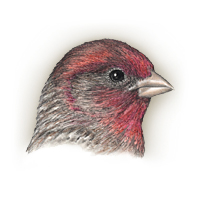 |
House Finch
Carpodacus mexicanus |
|
|
STANFORD LOCATIONS: Abundant resident in various habitats throughout campus. Frequently nests on artificial substrates, such as planters and the eaves of buildings. Similar Species: Purple Finch |
 |
Location |
Type |
Mating System |
Parental Care |
2ndary Diet |
Strategy |
|
|
|
|
I: 12-14 DAYS ALTRICIAL |
|
|
|
BUILDING 5 feet - 35 feet |
F |
MONOG (POLYGYN) |
MF |
BUDS TREE SAP |
|
| BREEDING: | Arid scrub, open woodland, urban areas, cultivated land. 1-3 broods, possibly dependent on age of adults. |
| DISPLAYS: | Courtship: singing male follows female, fluttering wings; hops about female with raised tail, drooped wings, raised head and crest feathers, continues singing. Female may sing short song. |
| NEST: | Variable placement including appropriation of other species' nests; of twigs, grass, debris, leaves, rootlets, hair. Often reused for later broods. |
| EGGS: | Bluish-white or pale bluish-green, sparsely marked with brown, black, often wreathed. 0.8" (19 mm). |
| DIET: | Consumes virtually no insects; feeds nestlings almost entirely on seeds. |
| CONSERVATION: | Winters within N.A. Uncommon cowbird host in w, common host in e. Historic range confined to w; established in early 1940s on Long Island and now spread throughout e. Range in w also expanding. |
| NOTES: | Competition with House Sparrow in n e appears to be important factor in the sparrow s decline there. Incubating female occ fed by male. Average clutch size in w is 4, in e 5. Young highly variable in rate of posthatchlng development. Songs more complex in CA than in e. Flocks in nonbreeding season. |
| ESSAYS: | Feeding Birds; Vocal Functions; Average Clutch Size. |
| REFERENCES: | Aldrich and Weske, 1978; Bitterbaum and Baptista, 1979; Kricher, 1983; Leck, 1987; Wootton, 1987. |
| Help | Abbreviations | Species-Alphabetical | Species-Taxonomic | Essays-Alphabetical | |
| Except for Stanford Locations, the material in this species treatment is taken, with permission, from The Birder's Handbook (Paul Ehrlich, David Dobkin, & Darryl Wheye, Simon & Schuster, NY. 1988). | |||||